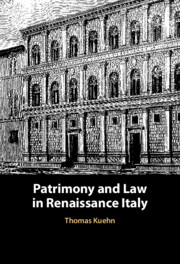Book contents
- Patrimony and Law in Renaissance Italy
- Patrimony and Law in Renaissance Italy
- Copyright page
- Contents
- Acknowledgments
- 1 Introduction
- 2 Bartolus and Family in Law
- 3 The Divisible Patrimony
- 4 Property of Spouses in Law in Renaissance Florence
- 5 Societas and Fraterna of Brothers
- 6 Fideicommissum and Law
- 7 Estate Inventories as Legal Instruments in Renaissance Italy
- 8 Prudence, Personhood, and Law in Renaissance Italy
- 9 Addendum
- 10 Conclusion
- Bibliography
- Index
5 - Societas and Fraterna of Brothers
Published online by Cambridge University Press: 24 February 2022
- Patrimony and Law in Renaissance Italy
- Patrimony and Law in Renaissance Italy
- Copyright page
- Contents
- Acknowledgments
- 1 Introduction
- 2 Bartolus and Family in Law
- 3 The Divisible Patrimony
- 4 Property of Spouses in Law in Renaissance Florence
- 5 Societas and Fraterna of Brothers
- 6 Fideicommissum and Law
- 7 Estate Inventories as Legal Instruments in Renaissance Italy
- 8 Prudence, Personhood, and Law in Renaissance Italy
- 9 Addendum
- 10 Conclusion
- Bibliography
- Index
Summary
Brothers often chose to remain together after their father's death, sharing the house and its furnishings, while pursuing common or separate enterprises. Such practices accorded well with advice and aspirations for continued family sharing. However, brothers' contributions were not so easily balanced, and eventually many fraternal households came to a division of assets, for which legal personnel, notaries and lawyers, were essential. Liabilities, which had nominally been shared while together, were also subject to division or denial. Jurists demanded an absolute standard (no separate accounting of holdings, earnings, and expenses) in order to hold liabilities in common. Here the legal presumptions of individual ownership proved deep-seated.
- Type
- Chapter
- Information
- Patrimony and Law in Renaissance Italy , pp. 100 - 136Publisher: Cambridge University PressPrint publication year: 2022

